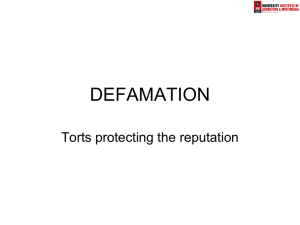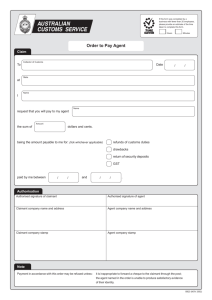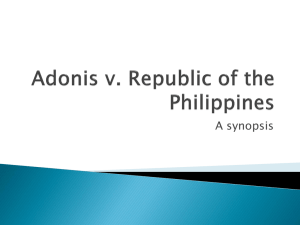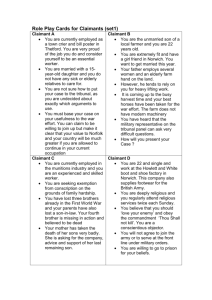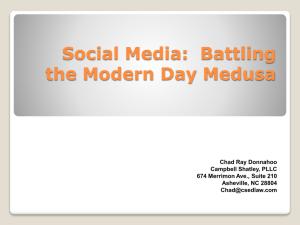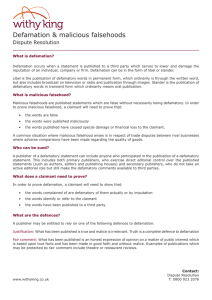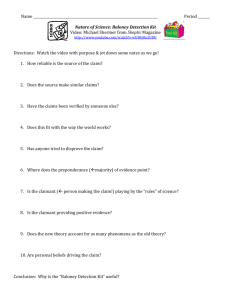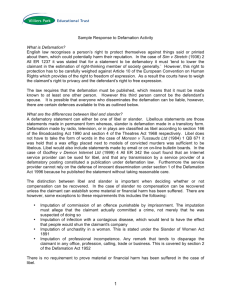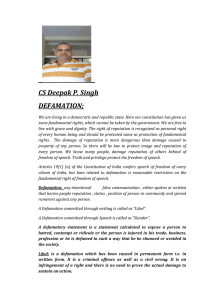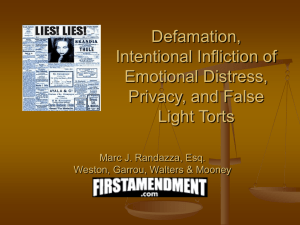defamation - Centre for Journalism
advertisement
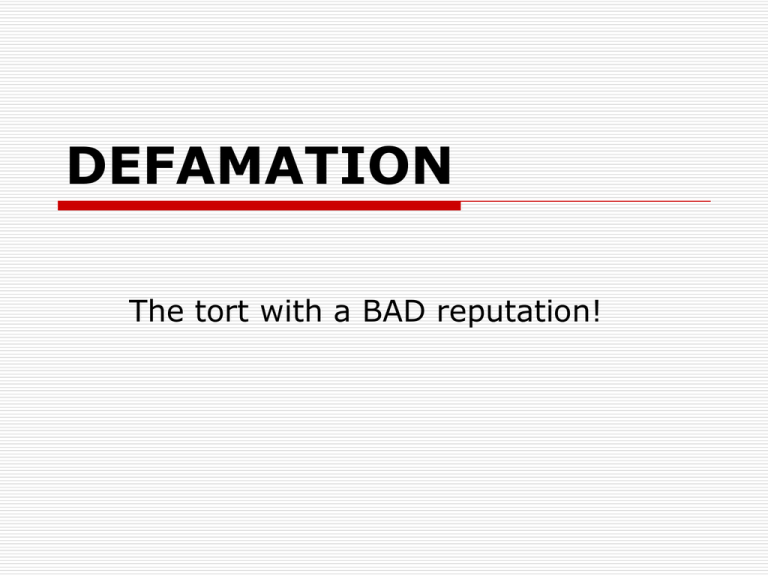
DEFAMATION The tort with a BAD reputation! WHY? OLD PROBLEMS… Too much burden on Defendant Complexity of law The ‘Chilling Effect’ on debate. See recent scientific research cases e.g. Singh - addressed in 2013 Act? Libel Tourism- will new Act make a difference? ‘A Town called Sue’ 2 WORTH REMEMBERING.. Defamation actions are brought to protect reputations so… People will sue even IF the information is TRUE See – e.g. Lance Armstrong, Jeffrey Archer, Jonathan Aitken, Liberace. 3 DEFAMATION ACT 2013 Is this the ‘cure’ for all the ‘faults’ in the law prior to 1st January 2014? Read the various views and opinions Act is now in force and applies to all material published after 1st Jan 2014. Read the Act online plus consultation and reviews 4 What IS Defamation? ‘…the publication of a statement which reflects on a person’s reputation and tends to lower him in the eyes of right-thinking members of society generally Or Tends to make them shun or avoid him’ 5 SOME NOTABLE CASES PRE 2014 Cairns v Modi - a tweet McAlpine v Bercow tweet + emoticon Cruddas v Calvert & Others Thornton v Telegraph Media Flood v Times Newspapers 6 Elements of Defamation The statement must be defamatory and It must refer to the claimant (i.e. identify him in some way) and It must be published i.e. communicated to at least one other person apart from the claimant 7 WHO CAN SUE? Any living individual – an action dies with the claimant/subject of the material Companies in respect of their business reputation and also directors of companies if comments reflect on them personally 8 And those who can’t…. BUT NOT local authorities, political parties, state corporations, trade unions or unincorporated associations See Derbyshire County Council v Times Newspapers 1993 & see comments of Lord Keith 9 DISTINCTION BETWEEN LIBEL & SLANDER Libel is the permanent form Slander is the non-permanent (normally spoken) form What is permanent? – books, anything printed, film, radio, TV, theatre performance, sculpture or artwork therefore ANYTHING we deal with as media organisations is LIBEL 10 DEFAMATION AND MALICIOUS FALSEHOOD Closely related but NOT the same BUT something defamatory may also come under heading of Malicious Falsehood. However, there must be an intention to cause loss for MF NO Intention required for defamation 11 Some cases involving this Joyce v Sengupta 1993 Thornton v Telegraph Media Group 2010 Cruddas v Calvert & others 2013 12 WHAT IS DEFAMATORY? Many things – words/phrases change meaning over time Even the definition is difficult Who are the right thinking members of society? Who is the reasonable reader/watcher/hearer? Is this even relevant now? See later…. 13 Roles of Judge and Jury Note there have only been one or two jury trials in last few years (e.g.Frankie Boyle). New Act states that juries will only be used on rare occasions. So Judge will now hear and decide case. Judge has to give reasons for decision – juries did not! 14 WHY the reduction in jury trials? Their use made trials longer and more costly e.g. See comments of SC in Spiller v Joseph 2010 Trials and issues very complex BUT could a jury serve a useful purpose? What do YOU think? 15 REQUIREMENT OF SERIOUS HARM This is an important new requirement for the claimant. Must show material has caused actual harm or is likely to cause serious harm to reputation of claimant Lachaux v Independent Print 2015 For trading bodies this means serious financial loss 16 Construction of words used 2 issues to consider a. what is the ‘ordinary & natural meaning’? May be the literal meaning or something obvious – reading between the lines ‘Bane & Antidote’ - take material as a whole – Charleston v News Group Newspapers 17 Construction continued… B. Innuendo or implication Must be some hidden meaning – Tolley v Fry & Sons Ltd 1930 Baturina v Times Newspapers Ltd [2011] 1 WLR 1526 Juxtaposition – Monson v Tussauds [1894] 1 QB 671 18 INNUENDO CONTINUED If statement is capable of more than one meaning the claimant MUST be able to show that people would take the defamatory meaning as the true one – Important! Is the material’ mere vulgar abuse’? 19 The advert for ‘Tolley’ The Caddy to Tolley said ‘Oh Sir, Good Shot Sir! That ball see it go, Sir. My Word how it flies Like a cartet of Frys They’re handy, They’re good and priced low, sir.’ 20 What is the claimant accused of? ‘Chase’ levels 1 – 3 Level 1 – the claimant is guilty of a serious offence Level 2 – there were grounds to suspect him of something serious Level 3 – there were grounds to investigate the matter – See Flood 2012 21 CLAIMANTS Must be identifiable – may be tricky Care must be taken in reportsenough material to identify the correct person! King v Dog World (2003) Can you defame a group? Possibly but it all depends on the size of the group 22 PROBLEMS WITH THE INTERNET Responsibilities of ISPs – new rules under s.5 of Act Mumsnet case Applause Store Productions & Firsht v Raphael (2008) - Facebook case Taking material down and the ‘publication rule’ ‘John Doe’ & ‘Spartacus’ orders 23
